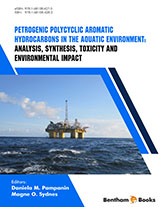Abstract
Considering their recalcitrance and toxicity, understanding how PAHs are removed from the marine environment is essential in order to maintain healthy and functional ecosystems. This chapter discusses the major advances in knowledge in the field of polycyclic aromatic hydrocarbon (PAH) biodegradation regarding key players, degradation mechanisms, genetic background, environmental factors influencing biodegradation and the role of interaction among microbial community members. Microbial degradation, or biodegradation, is the natural mechanism by which PAHs are channeled back into the marine carbon cycle and transformed into harmless material. The key players in this process are specialized bacteria, which developed strategies to utilize PAH as carbon and energy source. The rate of biodegradation is one of the major concerns in terms of bioremediation efforts. Factors influencing the rate at which PAHs are converted include temperature, oxygen concentration, availability of nutrients, type and bioavailability of PAHs, and the level of adaptation of the local microbial community.
Keywords: Biodegradation, Marine hydrocarbon degrading bacteria, PAHs.












